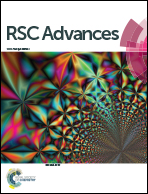Palladium-catalyzed desulfitative C–P coupling of arylsulfinate metal salts and H-phosphonates†
Abstract
Catalyzed by palladium(II) chloride, a diverse range of arylsulfinate sodium, potassium, lithium, silver, zinc, and copper salts undergo desulfination/C–P coupling with H-phosphonates, in the presence of silver(I) carbonate as oxidant, to produce useful arylphosphonates under microwave irradiation.


 Please wait while we load your content...
Please wait while we load your content...